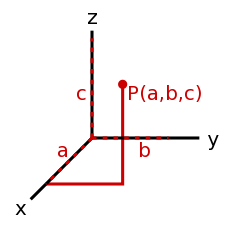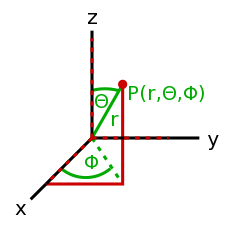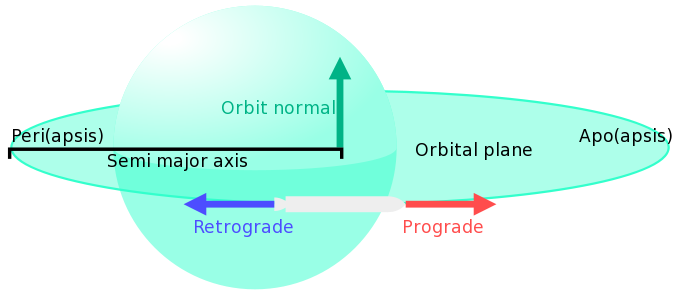Terminology/it
From Kerbal Space Program Wiki
In KSP, ci sono molti termini relative alla fisica e a come orbitae, che spesso possono essere fonte di confusione per i non tecnici. Inoltre, vari altri termini e abbreviazioni scientifiche sono utilizzati per descrivere termini comuni. Questa scheda è progettata come una tabella di ricerca concisa di termini necessari per aiutarvi a iniziare la strada per essere un astronauta a pieno titolo!
Contents
Matematici
- Ellisse
- Di forma ovale, spesso in riferimento alla tua orbita.
- Vettore normale
- Un vettore perpendicolare al piano.
- Scalare
- Un singolo valore senza direzione. Gli scalari sono seguiti dall'unità di misura che dice quello che la dimensione scalare riferisce. eg 3m/s, 3 e 3 sono scalari: sono le unità che denotano velocità, cioè lunghezza/distanza, e tempo rispettivamente.
- Vettori
- Un'insieme di direzione e valore. Come un vettore viene espresso dipende da quale sistema di coordinate si usa e quante dimensioni sono prese in considerazione. <35°, 12> è un vettore polare a due dimensioni, dove <14, 9, -20> è un vettore Cartesiano a tre dimensioni. Ci sono altri sistemi di coordinate ma questi sono i più utilizzati.
- <35°, 12> rappresenta una freccia lunga 12 unità, partendo dall'origine (zero, l'angolo non importa perchè un punto non ha dimensioni) e una fine nel punto a 35° dal asse base (tipicamente l'asse x, gli angoli sono positivi in senso antiorario)
- <14, 9, -20> rappresenta una freccia partendo dall'origine (<0,0,0>) e una fine nel punto dove la coordinata x è 14, la coordinata y è 9 la coordinata z è -20.
- Il vantaggio di utilizzare le coordinate Cartesiane è che si sa esattamente dov'è la posizione finale, ma è più difficile da capire la traiettoria, in coordinate polari invece è facile per trovare la traiettoria, il lato negativo è che si conosce più difficilmente la posizione finale.
- Le seguenti qualità fisiche sono tutti i vettori: velocità, accelerazione, forza
- Un sistema di coordinate 3D ha bisogno
- Un punto di riferimento. Questa è l'origine.
- 3 vettori-base. Questi definiscono l'unità base di misura rispetto all'origine, sono gli assi x,y e z.
Termini per Orbitare
- Apside
- In un'orbita ellittica, il punto dell'orbita più lontano dal corpo attorno cui si sta orbitando.
- Periapside
- In un'orbita ellittica, il punto dell'orbita più vicino al corpo attorno cui si sta orbitando.
- Periapside e Apside
- Quando parliamo di orbite a volte le parole "Periapside" e "Apside" sono modificate per specificare a quale pianeta o luna l'orbita si riferisce. Per esempio i suffissi -kee e -kerb sono comunemente usati per l'orbita attorno a Kerbin, diventando Perikee/Perikerb e Apokee/Apokerb.
- Nodo Ascendente
- Il Nodo Ascendente è il punto in cui l'oggetto che orbita interseca il piano di riferimento passando dall'emisfero sud all'emisfero nord. In questo casoz "nord" indica la parte superione del piano di riferimento.
- Nodo Discendente
- Il Nodo Discendente è il punto in cui l'oggetto interseca il piano di riferimento passando dall'emisfero nord all'emisfero sud.
- Eccentricità
- Un valore che descriva la modalità non circolare l'orbita è l'eccentricità.
- ecc = 0 → orbita circulare.
- 0 < ecc < 1 → orbita ellittica.
- ecc = 1 → orbita parabolica - questa è un'orbita di fuga.
- ecc > 1 → orbita iperbolica - questa è un'orbita di fuga.
- Inclinazione
- L'angolo tra il piano orbitale e il piano di reference (e.g. un'orbita con un'inclinazione di 90° ad un piano di riferimento equatoriale sarebbe chiamata polare).
- Orbita Bassa
- Un'orbita sufficiente, fuori dall'atmosfera, per evitare di cadere sul corpo a cui si sta orbitato intorno. Orbite basse sono utilizzate come step dopo la salita e prima del contatto con un altro oggetto (pianeta o nave), in quanto consente di bruciare pochissimo carburante per compiere una manovra in qualsiasi direzione. Un orbita bassa per Kerbin è in genere tra i 80 e i 100 km. Per i corpi senza atmosfera si può teoricamente consentire un'orbita a qualsiasi altezza dal suolo, ma al di sotto dei 10 km il rischio di schiantarsi in montagna o altro terreno elevato diventa molto alto. Il Time Warp è limitato a bassi valori mentre si è in orbite basse.
- Nodes Orbitali
- Specifici punti di riferimento in ogni orbita, come Apside, Periapside, i punti di intersezione con altre orbite.
- Orbite Normali
- Un vettore normale sul piano orbitale esso è costituito dal prodotto della velocità della nave e della forza di gravità. Dal momento che questo segue la regola della mano destra, da una prospettiva in cui la nave è in orbita in senso antiorario esso punterà "in alto", mentre per una nave orbitante in senso orario esso punterà "in basso". "Su" è anche spesso segnato come "Nord" o "N+", e altrettanto "Down" viene segnato come "Sud" o "N-".
- Piano Orbitale
- Il piano immaginario descritto dal percorso di un orbita attorno a un corpo (comunemente utilizzato per descrivere inclinazioni).
- Progressione
- La direzione, in senso antiorario, in cui una nave viaggia lungo il suo percorso orbitale. Poiché orbite sono ellittiche, è sempre tangente all'orbita nel punto in cui è la nave.
- Regressione
- Inverso di Progressione, in senso orario.
- Piano di Riferimento
- Qualsiasi piano utilizzato come riferimento per descrivere la vostra orbita attuale. Per le orbite locali di un pianeta è spesso il piano equatoriale. Quando più corpi in un sistema solare sono coinvolti può essere utilizzato il piano dell'eclittica. Per intercettare un altro corpo orbitante, viene utilizzato il piano orbitale del corpo da intercettare. Un piano orbitale può essere completamente descritto dando l'inclinazione e la longitudine del nodo ascendente rispetto ad un piano di riferimento.
- Semiasse Maggiore
- L'Asse maggiore è l'asse più lungo di un'ellisse, e il Memiasse Maggiore è la metà di questo. In KSP il Semiasse Maggiore è calcolata con Failed to parse (syntax error): {\displaystyle \ text {} sma = \ text {raggio} + \ frac {Ap + Pe} {2} </ math>. Esso è la media del Apside e del Periapside calcolata rispetto al centro del corpo. In quanto entrambi sono calcolati rispetto alla superficie del corpo, il raggio deve essere aggiunto. Tutte le orbite con lo stesso Semiasse Maggiore hanno lo stesso periodo, indipendentemente dalla loro eccentricità. ;<span id="suborb">Sub-orbital</span> :Describes an orbit where the periapsis is below the surface of a planetary body. If a suborbital path is followed for too long the orbiter will collide with the body being orbited. ;<span id="TWR">Thrust-to-weight ratio</span> {{See also|Thrust-to-weight ratio}} :<math style="float:right;padding:.5em;">\text{TWR} = \frac{T}{W} = \frac{T}{m \cdot g}} The Ratio between the total mass of the vehicle and the available thrust of all propulsion devices of the vehicle/current stage. A TWR greater than 1 means the craft will have enough thrust to accelerate vertically and gain altitude. A TWR below 1 means that the craft won't be able to counteract gravity and drag at low altitudes, although in space it only means that maneuvers will take longer. Because the weight (W) depends on the current gravitational acceleration (g) the TWR depends on which body is currently influencing the craft. The acceleration on the Mun's surface is only 16.6 % of Kerbin's acceleration, so at the surface a TWRKerbin = 1 would be a TWRMun = 6.
The ship orientation is always relative to an specific object. The terms are usually defined relative to the cockpit.
- Zenith
- Top side of the ship which is usually oriented away from the orbited body. Opposite of nadir.
- Nadir
- Bottom side of the ship which usually oriented towards the orbited body. Opposite of zenith.
- Port(side)
- Left side of the ship. Opposite of starboard.
- Starboard
- Right side of the ship. Opposite of portside.
- Front
- Front side/end of the ship which is usually towards the nose or prograde vector. Opposite of aft.
- Aft
- Back side/end of the ship which is usually housing the primary rockets and facing in retrograde. Opposite of front.
Manovre nello spazio
- Atmospheric Braking
- → Articolo principale: Aerobraking
- Lowering the periapsis so it is inside a planetary atmosphere. This will lead to the vessel being slowed by atmospheric drag. Can lead to reentry (see below), but also is used to reduce the necessary burn time for significant orbit alterations.
- Burn
- firing of the engines, usually to alter trajectory in some way.
- Circularizing
- A maneuver (firing of the engines) that makes an orbit's eccentricity 0, or close to zero. This is usually achieved by a burn close to an apsis.
- Maneuver Node
- → Articolo principale: Maneuver node
- Maneuver nodes are a nice tool to plan and project trajectory changes in map view prior to doing the actual burn.
- Re-entry
- Re-entering atmosphere and using drag to decelerate a vessel to a groundwards trajectory. This usually causes intense heat stress on the object as the vessel requires sufficient speed to not "bounce" back from the atmosphere into space. Currently (0.21.1[outdated]) re-entry is only partially implemented with effects but heat and bounce are not yet implemented. (There are mods however)
- Retroburn
- A burn performed "backwards", e.g. with the engines facing towards prograde and nose towards retrogade (hence the name). This is a common maneuver to used to lower the height of the orbit without altering any other orbital parameters.
Fisica
- Acceleration
- Rate of change to your velocity. Acceleration is a vector, measured in "m/s2".
- Ballistic trajectory
- A falling object's trajectory is ballistic. In rocketry it usually indicates that the object in question is only influenced by gravity and does not exert any force (ie. thrust) of its own.
- Delta-v (Δv)
- The change in velocity that has or can be exerted by your spacecraft. This is measured in meters per second (m/s). More mass can reduce the delta-v, while more propulsion can increase it. This makes it a useful value to calculate efficiency of launch vehicles. For example, a launch vehicle requires about 4,000 m/s of delta-v to escape Kerbin's atmosphere and achieve a stable orbit.
- Energy
- → See also: Specific orbital energy on Wikipedia
- The energy of an object in an orbit is the sum of its potential and kinetic energy. The potential energy is and kinetic energy where G is the gravitational constant, M is the mass of the body, m is the mass of the craft, R is the distance from the center of the body and v is the velocity. This results in . This sum stays the same when not thrusting: When approaching periapsis potential energy is transferred into kinetic energy. After passing the periapsis the kinetic energy is converted back into potential energy. When the energy or specific orbital energy is greater than zero the vehicle is on an escape trajectory.
- There is also the specific orbital energy () which doesn't require the mass of the craft: , , . All orbits with the same semi-major axis (a) have the same specific orbital energy.
- Escape Velocity
- The velocity needed to escape a given planet's gravity well, as given by where G is the gravitational constant, M is the mass of the planet, and r is the radius of the planet.
- g-force (G)
- A measurement of acceleration as expressed in the sea-level force of Earth's gravity with 1 G being about 9.81 m/s². An object at Earth's surface is accelerated at 1 G. The object weighs twice as much when at 2 G acceleration and is weightless when accelerated with 0 G. In free fall, like in orbit, and without an engine running or an atmosphere applying drag all objects experience no acceleration which can be expressed as 0 G.
- Gravity
- The force exerted by all objects with mass. Very weak. Usually only objects with very high mass - ie. planets, moons - have any noticeable effect. Diminishes with the square of distance from the center of mass. So for an object twice as far, experiences only 1/22 = 1/4 of the gravity.
- Gravity Well
- The area around a planet affected by gravity. Actually extends to infinity, but as gravity decreases quadratically with distance (if you multiply by 2 the distance, the gravity is divided by 4), it is only significant within the planet's sphere of influence.
- Orbit
- → Articolo principale: Orbit
- When an object has sufficient tangential velocity (and is outside the atmosphere, so drag won't slow it down) so that it will keep falling "next" to the planet (never touching ground) its trajectory is called an orbit. Stable orbits are elliptical (a circle is an ellipse with zero eccentricity). If the objects tangential speed exceeds escape velocity it's orbit will be either para- or hyperbolic.
- Specific Impulse (Isp)
- → Articolo principale: Specific impulse
- The Isp defines how effective a propulsion system is. The higher the Isp the more powerful is the thrust applied to the rocket with the same fuel mass. The Isp is usually given in seconds but actually the physically correct unit is distance per time which is usually given in meters per second or feet per second. To avoid confusion which unit of speed is used, the physical correct Isp (in distance/time) is divided by the surface gravity of Earth (9.81 m/s²). This results in a value given in seconds. To use this Isp in formulas it must to be converted back into distance per time which requires multiplying with the surface gravity of Earth again. As this value is only used to convert between those two units, the specific impulse doesn't change when the gravity changes. It appears that KSP use a value like 9.82 m/s² and thus using a little less fuel.
- As the specific impulse is the ratio of thrust and fuel flow is sometimes given as the unit. This is mathematically another form of because force is the multiplication of mass and acceleration defining . So with the later begin simply only in SI base units.
- Sphere of influence
- The radius around a celestial body where its gravity well is non-neglectable. Commonly known as SoI/SOI.
- Tangential velocity
- The component of your velocity that's tangential to your trajectory. Instantaneous velocity - velocity when the time of measurement approaches zero - is always tangential to your trajectory.
- Trajectory
- A trajectory is the path that a moving object follows through space as a function of time.
- Velocity
- Rate of change of your position. Your speed and direction. Velocity is a vector, measured in meters per second (m/s).












![I_{{sp}}={\frac {T}{{\dot m}}},[I_{{sp}}]={\frac {m}{s}}](https://en.wikipedia.org/api/rest_v1/media/math/render/svg/7ff940eef93d9743a07d72ba2bb808e3b0372c36)



